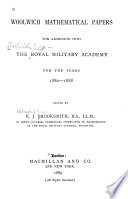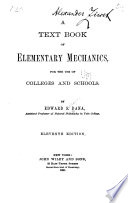 | Joshua Joseph J. Doherty - 1884 - 178 pages
...experimentally ? 10. State and prove the Triangle of Forces. 1t. Show that if three forces acting on a particle be in equilibrium, each force is proportional to the sine of the angle between the directions of the other two. 1 2. State and prove the Polygon of Forces. 13. State and prove the Parallelopiped... | |
 | Woolwich roy. military acad - 1884 - 148 pages
...the axioms assumed in the Theory of Statics. i. Shew that if three forces acting on a point keep it in equilibrium, each force is proportional to the sine of the angle between the directions of the other two. 3. A weight Q hanging freely over a pully supports P, which rests on an... | |
 | E. J. Brooksmith - Mathematics - 1889 - 356 pages
...the axioms assumed in the Theory of Statics. 2. Shew that if three forces acting on a point keep it in equilibrium, each force is proportional to the sine of the angle between the directions of the other two. 3. A weight Q hanging freely over a pulley supports P, which rests on... | |
 | Edward Salisbury Dana - Mechanics - 1881 - 320 pages
...R. First Method. If the three forces P, W, R, acting together at 0, are in equilibrium, then (133) each force is proportional to the sine of the angle between the directions of the other two. That is, P : W : R = sin WOR : sin FOR : sin WOP, = sin (180° - a) :... | |
 | Denison Olmsted - Physics - 1891 - 496 pages
...forces— P along EF, W along EW and a force, opposite to their resultant, along E B. From Art 44, each force is proportional to the sine of the angle between the other two. Hence, P : W :: (sin WE 11 =) sin B ED : (sin BEF=) 2 B ED. 123. Change in the Ratio of Power and Weight.—... | |
 | William Briggs, George Hartley Bryan - Statics - 1894 - 254 pages
...zero. Therefore the forces are in equilibrium. *34. Kami's Theorem. — If three forces keep a particle in equilibrium, each force is proportional to the sine of the angle between the other two. Let the forces P, Q, E act along OP, OQ, OR. If they are in equilibrium, we have, by § 32, sum of... | |
 | Charles P. Matthews - 1902 - 272 pages
...plane are in equilibrium their lines of action meet in a point. 1 60. Show that when three forces are in equilibrium each force is proportional to the sine of the angle between the other two (Lami's theorem). 161. Find by graphic construction the resultant of four forces of 3, 7, 5, and 12... | |
 | Encyclopedias and dictionaries - 1897 - 846 pages
...(and substituting the sines of the supplementary angles) : : sin. QAR' : sin. PAR : sin. PAQ; that is, each force is proportional to the sine of the angle between the directions of the other two. TBIANGTJLA'TION: operation of dividing any portion of the earth's surface... | |
 | Eldred John Brooksmith - Mathematics - 1901 - 368 pages
...importance is attached to accuracy. NB — g may be taken = 32.] 1. If three forces acting on a particle are in equilibrium, each force is proportional to the sine of the angle between the other two. ABCD is a quadrilateral, having the angles at A and D right angles, and CB = CD. Forces P, Q, and K,... | |
 | William Woolsey Johnson - Mechanics - 1901 - 484 pages
...distance between the lines of action of the other two. We have seen in Art. 50 that, in the general case, each force is proportional to the sine of the angle between the lines of action of the other two. The present proposition is in fact the limiting case of the former.... | |
| |